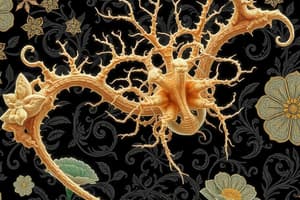Podcast
Questions and Answers
What is the role of the endoderm during embryonic development?
What is the role of the endoderm during embryonic development?
- It induces the formation of mesodermal organs. (correct)
- It forms the muscular layer of the gut.
- It develops into the central nervous system.
- It creates the dermal layer of the skin.
Which structure is primarily responsible for gas exchange and excretion in the developing embryo?
Which structure is primarily responsible for gas exchange and excretion in the developing embryo?
- Allantois (correct)
- Pharyngeal arches
- Gut tube
- Lung buds
What defines the closed ends of the primitive gut during embryonic development?
What defines the closed ends of the primitive gut during embryonic development?
- Endoderm and mesoderm junctions
- Oropharyngeal and cloacal membranes (correct)
- Cranial and caudal membranes
- Lateral and dorsal folds
During the development of the lung, what is the term used to describe the structure from which it buds off?
During the development of the lung, what is the term used to describe the structure from which it buds off?
What completes the formation of the gut tube during embryo development?
What completes the formation of the gut tube during embryo development?
Flashcards are hidden until you start studying
Study Notes
Primordial Germ Cells
- Origin of gametes, crucial for reproductive development.
Endoderm
- Induces formation of mesodermal organs, such as the heart and blood vessels.
- Forms the lining of the digestive tract, which spans the entire body length.
- Buds off into several organs: liver, gall bladder, pancreas, and lungs.
- Cranial end, anterior to lungs, develops into the pharynx.
- Epithelial pockets in the pharynx give rise to the thyroid, thymus, and parathyroid glands.
Development of Stomach
- The stomach undergoes rotation during development.
- Dorsal side shifts to the left, while the ventral side shifts to the right.
PGC Migration
- Primordial germ cells migrate to specific locations for further development.
Body Folding
- Embryo undergoes folding, essential for later developmental stages.
Development of Endodermal Organs
- Lung development involves budding from the endoderm, also referred to as the respiratory diverticulum, signifying a blind-ending tube.
- "Next bifurcation" indicates further branching of lung structures.
Gut Tube Formation
- Completion of the gut tube occurs through lateral folding of the embryo.
- Mesodermal layers are recruited to the gut wall during this folding process.
- Splanchnic mesoderm contributes to the mesodermal layer of the gut tube.
- Somatic mesoderm later lines the body cavity.
Allantois
- An endodermal structure encased by blood vessels, which develop into umbilical arteries and veins.
- Functions as a sac-like structure aiding gas exchange and excretion.
- Eventually becomes the urachus, linking the fetal bladder to the yolk sac.
Development of Gut
- The primitive gut starts to form by the beginning of the fourth week of embryonic development.
- The cranial end is sealed by the oropharyngeal membrane.
- The caudal end is sealed by the cloacal membrane.
- These three gut regions are classified based on their distinct blood supply.
Studying That Suits You
Use AI to generate personalized quizzes and flashcards to suit your learning preferences.





